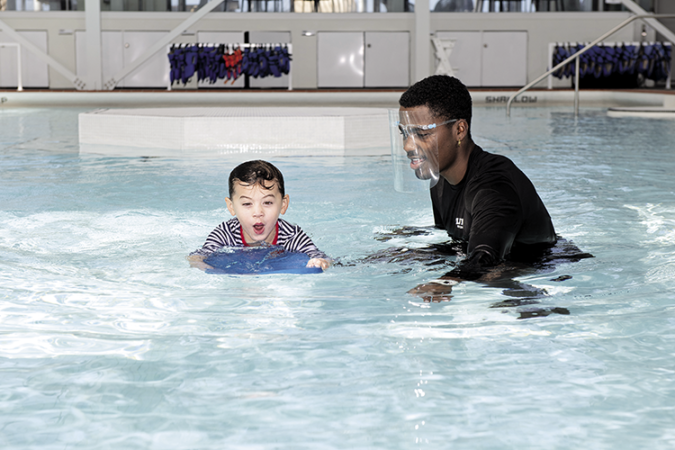Playing in or around water is one of the joys of summer, but this treasured seasonal pastime comes with some serious risks. Drowning is the second-leading cause of accidental death for children under the age of 14 in the United States, according to the Centers for Disease Control and Prevention.
As COVID-19 restrictions ease, many families will have more informal gatherings and take trips to the beach, increasing the potential for children to have unsupervised access to water sources. Because of this, it’s important for children to take swimming lessons to learn water safety skills and create safer habits in and around water. As swimming lessons begin across the country, many are being conducted safely with COVID-19 precautions in place.
Protect your family’s safety around water this summer with these tips from the Make a Splash Tour, presented by Phillips 66 and the USA Swimming Foundation.
Designate a Water Watcher and Closely Monitor Children. Designate a water watcher when you are in, on or around water. Watch all children and adolescents swimming or playing in or around water, even if they know how to swim. Keeping young children or inexperienced swimmers within arm’s length at all times can help ensure you’re able to provide assistance if and when it’s needed.
Wear a Life Jacket. Anyone participating in any boating, paddling or towed water sports, regardless of swimming ability in pool or open water situations, should wear a Coast Guard-approved life jacket. Preschool-aged children (5 years old and younger), who are not protected by touch supervision, in particular, should always wear a life jacket. Swimming aids and water toys – such as water wings, inflatable water wings and rings – are not intended to be life-saving devices. They may provide some buoyancy in the water but do not prevent drowning.
Swim with a Buddy. When possible, choose swimming locations where a trained lifeguard is watching for dangerous conditions and helping keep an eye on swimmers. Also make it a practice to always have at least two people swimming together. That way, if someone has a problem, the other can get help.
Learn to Swim. Research has shown formal swimming lessons reduce the risk of childhood drowning by 88%. Through the annual Make a Splash Tour, the USA Swimming Foundation, with the support of Phillips 66, encourages children’s swim lessons. By equipping your child with the skill of swimming, you’ll open doors to a lifetime of safety, fun, fitness and even employment opportunities.
While lessons progressively teach a variety of swimming strokes, some of the most important things swimmers learn – even in beginner classes – are breath control and how to float. These basic skills are essential for staying above water should someone find himself or herself unable to touch or too tired to swim to safety. Children can participate in swimming lessons before they can walk, and parent-child swim lessons provide bonding opportunities along with water safety education.
Enter Water Feet First. Diving in a pool that is too shallow or into water where you’re not certain what’s below the surface, like a lake, can have dire consequences. Teach children to dive only in designated diving areas and to always enter water of unknown or non-visible depth feet first.
Swim in Designated Areas and Obey Posted Signs and Flags. Ropes, buoys and flags in larger bodies of water like lakes or oceans are commonly used to mark off safe swimming areas and provide visual cues about changes in depth, underwater surfaces and currents. Teach children what these signs and markers mean and that they’re in place as safety tools, not toys to play with or float on.
Learn CPR. If the unthinkable does happen, knowing how to perform CPR allows you to take immediate action, which has been shown to significantly better the outcome for children with submersion injuries. In the time it takes for paramedics to arrive, you could save someone’s life. Seconds count; the more quickly lifesaving CPR is started, the better the chances of recovery. There are many places that offer CPR training, including community organizations and nonprofit groups. Remember to keep your certification current once you have completed the initial requirements.
Make safety a priority for your summer water fun. Find more information, including swim lesson providers in your area, by visiting usaswimming.org/makeasplash.
Finding a Swim Lesson Provider
If you’re unsure where to take your child for swim lessons in your community, these tips can help:
* Ask other parents in your area where they take their children. You can ask people you know and use social media and neighborhood boards to get tips. If your school has a swimming team, the coach may also be able to give you some ideas.
* Another resource is online search tools, such as usaswimming.org/makeasplash, which allows you to search for swim lesson providers near you. Many of these programs also offer options for free or reduced-cost swim lessons.
* Once you identify a program, visit the facility with your child to see how swim lessons are run.
* Find out who your child’s teacher will be and whether it’s possible to meet him or her in advance.
* Learn the program expectations for you as a parent or guardian.
* Inquire about the provider’s approach and learn-to-swim philosophy.
While researching programs, some industry best practices to look for include:
* Ask about the facility’s COVID-19 mitigation protocols. Swim lessons can be safely administered with proper protective equipment and procedures.
* A nationally recognized learn-to-swim curriculum or an independently developed learn-to-swim curriculum that follows a similar model.
* Trained and certified instructors, with on-deck lifeguards holding current CPR and first aid certifications.
* A maximum 6-to-1 student-to-instructor ratio for group lessons.
* Minimum of 30 minutes per week of in-water instruction with a minimum total in-water instruction time of four hours.
* Written and practiced emergency action plans.
* Regulation of the facility and water by the Department of Health or similar governing agency.
* Established and practiced child-protection policies.
* Screening and background checks on all staff members. (Family Features & USA Swimming Foundation and Phillips 66)





Leave a Comment
Your email address will not be published. Required fields are marked with *